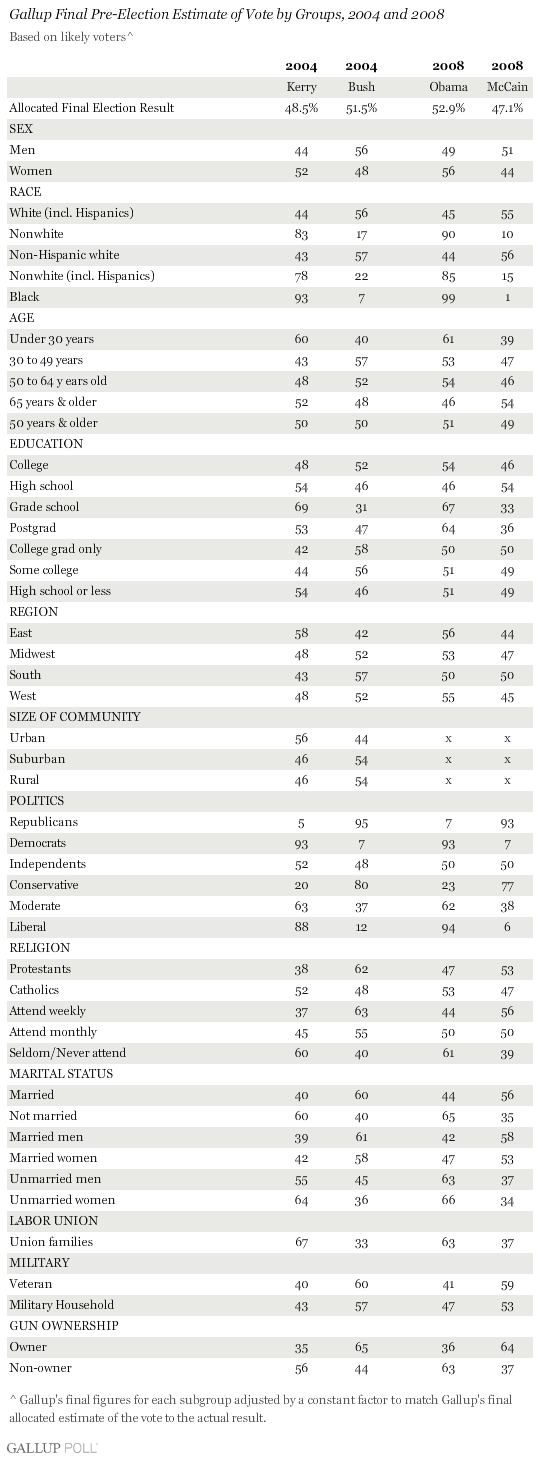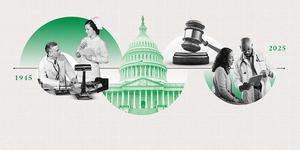PRINCETON, NJ -- The final pre-election Gallup Poll Daily tracking survey of nearly 2,500 likely voters shows that Barack Obama won the 2008 presidential election with practically total support from black Americans, and heavy backing from those with postgraduate educations, young adults (male and female alike), and non-churchgoers. At least 6 in 10 voters in all of these categories cast their votes for Obama.
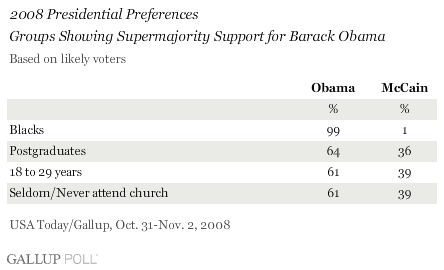
Additionally, across Gallup's Oct. 31-Nov. 2 final pre-election tracking, Obama won majority support nationwide from women, middle-aged adults (30 to 49 and 50 to 64 years of age), and Catholics.
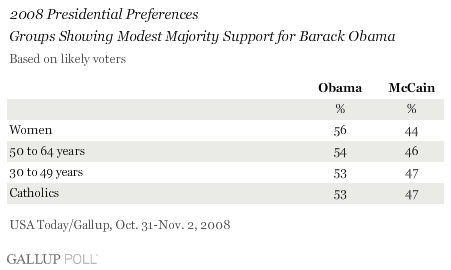
These findings are aside from the typical political support patterns whereby Democrats and liberals are reliably strong supporters of the Democratic presidential candidate, and Republicans and conservatives are strong supporters of the Republican.
Among likely voters, 93% of each partisan group supported their own party's candidate for president and 7% of each supported the opposing party's candidate. Political independents were evenly divided at 50%. The advantage for Obama came from the fact that many more voters who participated in the 2008 election were Democratic in their party orientation than were Republican (39% vs. 29%).

Additionally, certain groups historically aligned with each party showed predictably high support for that party's candidate. Most voters living in households with at least one union member backed Obama, while veterans and gun owners were solidly behind McCain.
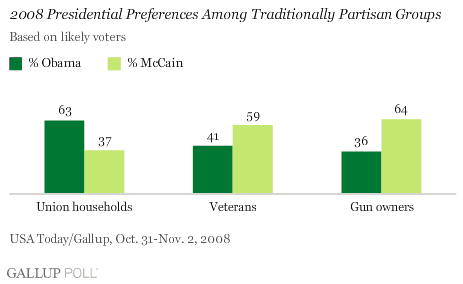
McCain's Hobbled Coalition
John McCain's principal electoral strengths on Tuesday were with frequent churchgoers, whites, seniors, Protestants, and men. However, for all except Protestants, the extent of support he received from these groups was not as great as Obama's support from their counterparts (non-churchgoers, blacks, young voters, Catholics, and women).

What Changed Since 2004?
Gallup's preliminary analysis of the trends in voting among various subgroups suggests that Obama outperformed other recent Democratic nominees in attracting the near-universal support of blacks. Black support for the Democratic candidate is always high, but their 99% support for Obama exceeded the 93% received by John Kerry in 2004, the 88% support for Bill Clinton in 1992 and the 88% support for Mike Dukakis in 1988. Clinton approached universal support from blacks with his 96% backing in 1996, as did Gore in 2000 with 95%.
There was virtually no change in the percentage of white voters supporting the Democratic candidate in each of the last four presidential elections, ranging from 43% to 46%, with Obama's 45% about average.
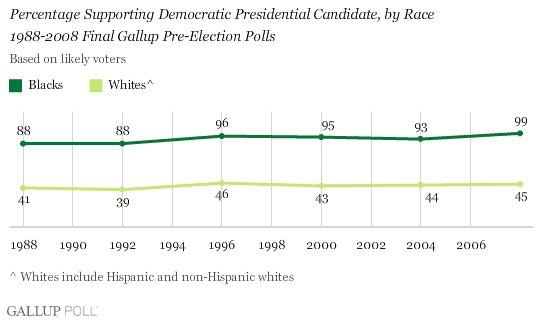
Gallup's 2004 final pre-election polling showed young voters heavily favoring the Democratic nominee (Kerry), as they did in the 2008 election. What changed is that middle-aged voters moved from the Republican column into the Democratic column. This more than offset a modest shift of seniors from the Democratic to the Republican side.

Another striking change between the 2004 and 2008 elections is the preferences of the most highly educated Americans. Obama attracted the highest level of support from postgraduate educated Americans (64%) of any recent Democratic candidate. Four years ago, 53% of this group backed Kerry, fairly typical of the historic pattern. Obama also made gains among college graduates and those with only some college. The only group to show a decline in support for the Democratic nominee in 2008 was those with no college education.
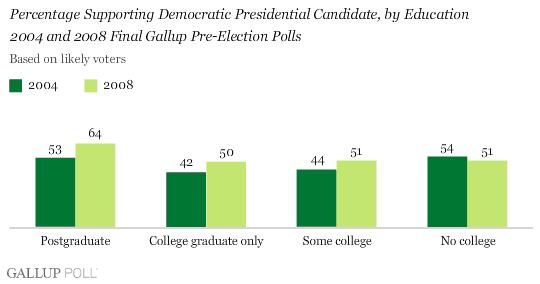
Where Did All the Republicans Go?
Obama and McCain fought hard during the campaign for the independent vote, and in the end it was a draw, with each getting 50% of the independent vote. However, that parity masks a more fundamental shift of voters away from the Republican Party over the past four years. In 2004, Republicans and Democrats were about equally represented in Gallup's final pre-election pool of likely voters: 39% were Republican, 37% Democratic, and 24% independent. This year, only 29% of likely voters were Republican and 39% Democratic, with 31% independent -- a political balance much more favorable to Obama than what Kerry faced in 2004.
Bottom Line
Obama's victory is owed in part to extraordinarily high support from blacks. Not only did nearly all blacks who participated in the election vote for Obama, but blacks came out in record numbers -- constituting 13% of Gallup's final likely voter pool, up from 8% in 2004.
Secondly, Obama achieved greater support than his Democratic predecessors from highly educated voters, and he attracted significant new support from middle-aged voters.
Thirdly, far fewer voters considered themselves Republican in this election than did so in 2004. Gallup polling has documented this decline over the past four years, along with a steep deterioration of President George W. Bush's approval rating. The resulting more pro-Democratic political climate in the country may be the ultimate reason Obama won.
Survey Methods
Results are based on telephone interviews with 3,050 national adults, aged 18 and older, conducted Oct. 31-Nov. 2, 2008. For results based on the total sample of national adults, one can say with 95% confidence that the maximum margin of sampling error is ±2 percentage points.
For results based on the sample of 2,824 registered voters, the maximum margin of sampling error is ±2 percentage points.
For results based on the sample of 2,472 likely voters (using Gallup's traditional likely voter model which identifies likely voters on the basis of current voting intention and past voting behavior), the maximum margin of sampling error is ±2 percentage points. The likely voter model assumes a turnout of 64% of national adults. The sample is weighted to reflect this assumption, so the weighted sample size of likely voters is 1,952.
Interviews are conducted with respondents on land-line telephones (for respondents with a land-line telephone) and cellular phones (for respondents who are cell-phone only).
In addition to sampling error, question wording and practical difficulties in conducting surveys can introduce error or bias into the findings of public opinion polls.
